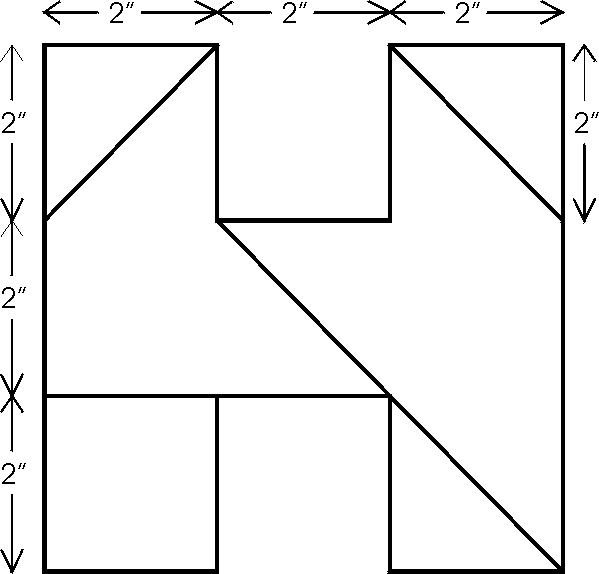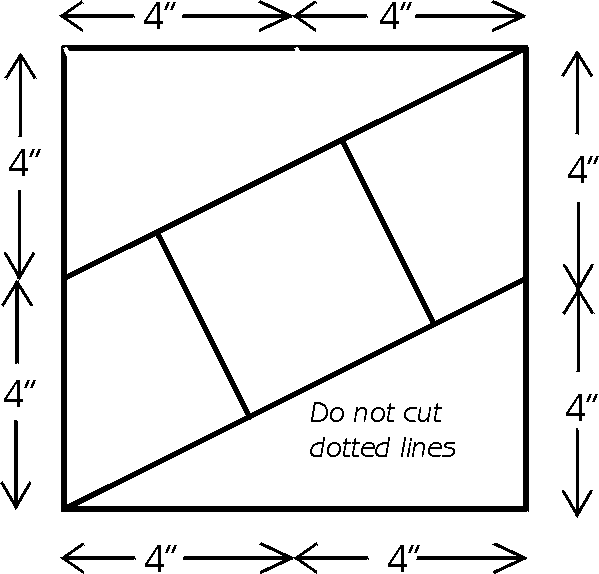|
|
Equipment:A rope or cloth tail and a token for each scout.
On the leader's whistle, scouts disperse around playing area. |
|
Equipment: a Hat, scarf or some other
'bacon'
Divide the group in half. Number off each half separately. If there are 20 boys in the troop, then you would have two groups, each numbered from 1-10. Line them up facing each other, about 30-40 feet apart. In numerical order. Place your 'bacon' between the lines at X. Now the field will look like this: 1 2 3 4 5 6 7 8 9 10
X O
<== Leader 10 9 8 7 6 5 4 3 2 1 The idea is for a scout to go out and
retrieve the object. The leader calls out a number, and each scout with that
number runs out and tries to get the object and go back behind his
line. |
NIM
 Each player in turn takes part or all of any pile of matches - taking at least one match. The game is over when the last match, or the remaining pile, is the winner. Or the rules may be reversed, making the player who picks up the last match the loser. |
"HEAVE, HO, THROW!" RELAY:
|
Divide the group into two teams. Take one
boy from each team about 20 feet from the rest of the group and have him sit
in a designated spot. During the game, he may lean forward slightly and reach,
but he cannot move from that spot. Give the first Scout in each line a coiled rope about 25 feet in length. Each boy makes one throw, holding onto the end. The sitting Cub Scout tries to reach the rope being thrown without moving from his spot. Each boy in the relay line will throw the rope once, and then go to the end of the line. Teams score whenever the sitting boy can reach the rope thrown to him. One point is given for each throw that the sitting boy catches. The team with the most points when all relay members have thrown is the winner. |
WATER DRINKING RELAY
|
Equipment: Cup of water, Plastic
spoons
Divide the boys into teams and give each player a cup of water and plastic spoon. The first player feeds the second player his cup of water one spoonful at a time. The second player feeds the third and so on. The first team finish wins. |
EASY GAMES
One-Armed Gift Wrap
Equipment:
|
Change Tag
| Fast and furious, this game is useful for working off excess energy and working up an appetite. Players move around freely while "It" tries to catch another player. As the players try to avoid him, "It" can be very crafty and call out the name of another player. This player then becomes "It's" temporary deputy and can touch other players for "It". The confusion just adds to the fun and speeds up the game. |
Second Hand Shop
|
Equipment: As many
old clothes, shoes, etc. as possible.
Place as many clothes of all kinds that you can possibly find in the center of the room. On the word "GO" the boys dash into the center and put on as many garments as possible. At the word "STOP" (a pre-set time limit) the boys return to the starting line. Have each boy count each article of clothing as he "disrobes." The one who had the most clothes on is declared the winner. |
RUNAWAY TRAIN
|
This is a den or pack tag game. It may be
played by individual dens or the pack. Designate one Cub Scout as the
locomotive. He will be IT. The rest of the boys will be runaway cars. When caught, they hook on behind the locomotive. The game contin-ues with all of the boys trailing along behind until all the boys are caught. |
CRACKER EATING
|
Two double crackers per player Give each boy two double crackers. The boy who can eat them all and whistle, or blow up a balloon wins. |
BALLOON STAMPEDE
|
Type: Pack or Den Game Equipment: Balloon for each player Each player has a balloon tied to his ankle. The object is to tread on and burst the other players' balloons, while trying to keep his own intact. |
Holiday Games
FILLING SANTA'S PACK
|
Form two den-size groups and line them up at opposite
sides of the room. Give one team balloons of one color; give the
other team a contrasting color. Ask them to blow up their
balloons and tie them. In the center of the room, have a large
container--but not one big enough to hold all the inflated
balloons. On signal, all players tap their balloons in the air and try to bat them into the container. When the container is full, stop the game. The team with the most balloons in the container wins. |
GATHERING SNOWBALLS
| Scatter cotton balls or golf-ball size newspaper wads on the floor. Give all players a wooden spoon. On signal, they try to pick up the balls with the spoons and put them in a large bowl on the table. No hands allowed. If you have only two spoons, run this as a duel contest. |
SANTA NODS
| Santa is in the center of a circle made by thc other players. Santa points at any player and says, "Santa says 'yes;" or "Santa says no'" That player must quickly nod "yes" or shake his head "no." If Santa says only "yes" or "no" without prefacing it with "Santa says" the player must not respond. If he does, he is eliminated. Santa should give commands quickly. The last person still in the game becomes the new Santa. |
| Each Cub Scout hops on one leg, holding the other. To win, he must make opponent lose balance or step out of circle by bumping shoulders. |  |
EXPLORING THE MISTY PLANET
| Tell
your den members that they have arrived on a planet so shrouded with mists
that they cannot see and must depend on their other four senses to gather
information. Blindfold each boy and have them sit around a table or in a
circle on the floor. Pass four "touch" objects around the circle, cautioning
the boys to remain silent. When all have felt the objects, place them out of
sight. Have the boys remove their blindfolds and write down in their "data
logs" (small booklets of four quarter-sheets of paper stapled together and
decorated for an alien planet) their guesses of what they have felt. Repeat
the process with four sounds, smell, and taste objects.
Suggested sound objects: sandpaper on wood, scissors, a spoon stirring in a ceramic mug, paper tearing Suggested touch objects: candy gummy worm, seashell, sycamore or sweet-gum ball, peanut Suggested taste objects: small piece of fruit, cheese, vegetable; toothpick dipped in catsup, chocolate syrup, honey, jam Suggested smell objects (place in small cup or bowl to pass around): cinnamon; lemon; peanut butter; potato chips; bath soap |
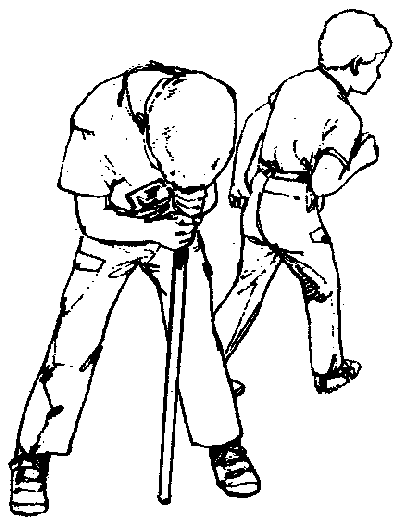 |
ASTRONAUT’S TEST. ASTRONAUT
RELAY. |
SPLASHDOWN
| Have the boys cut a space capsule outline about 3 inches high from plywood. Drill a hole in the top and attach a handkerchief parachute. Draw a 6-foot wide bull's-eye on the ground. In turn, the Cub Scouts stand about 25 feet away, fold up the parachute around the capsule, and try to throw it skyward so the "splashdown" hits the bull's-eye. | 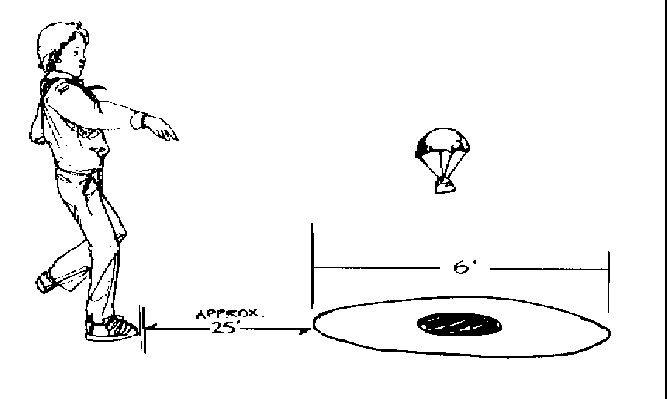 |
OXYGEN TANK RELAY
| Tell the boys they are on an alien planet and the oxygen in their housing complex is getting dangerously low. Divide the boys into two teams. Line them up with a large bucket of water (liquid oxygen) and cup for each team. At the other end of the field is an empty oxygen reservoir (large .jar) for each team. On a signal, the first boy in each line fills his cup with liquid oxygen, races to empty it into the oxygen reservoir, and returns the cup to the next boy in line, who continues the process. The first team to fill its oxygen reservoir wins. |
SPACE GLOVE CHALLENGE
| Tell the boys they will be collecting rock samples from an alien planet to bring back to study. Divide the boys into two relay teams. A pair of canvas gloves, a jar with a lid, and a plate full of popcorn kernels are at a goal line for each team of astronauts. On a signal, the first boy on each team runs to the goal, puts on the gloves, opens the jar, picks up five kernels one at a time, and puts them in the .jar. He then closes the lid, removes the gloves, and runs back to his team to tag the next player, who repeats the process. The first team whose players complete all the tasks wins. |
BACKYARD HOCKEY
| Lay out rink as shown with tape on grass or chalk on driveway. Sticks are three-foot broomstick lengths. Puck may be a "dead" tennis ball or dog toy low-bounce rubber ball. Players stay outside the rink and defend goal to their right. When the puck goes out of bounds, have a face | 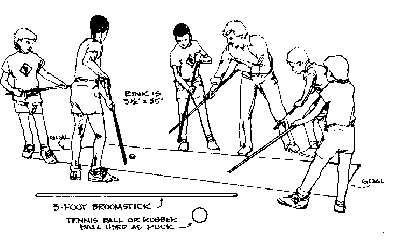 |
SIDEWALK TENNIS
| The court is two squares of sidewalk. Ball is a regular tennis ball or a rubber ball. The "racquets" are open hands. The net is the crack or line between the squares. Players try to hit the ball on one bounce into their opponent's square. Score as in tennis or table tennis. |
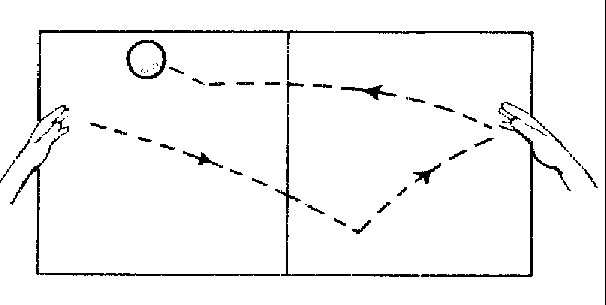 |
| Bury baby food jars to the rim for holes. Flags are paper triangles glued to Popsicle sticks. Add water hazards and sand traps as desired. All shots are taken knuckles-down as in regular marbles. Winner is the player who takes the fewest strokes to go around the course. | 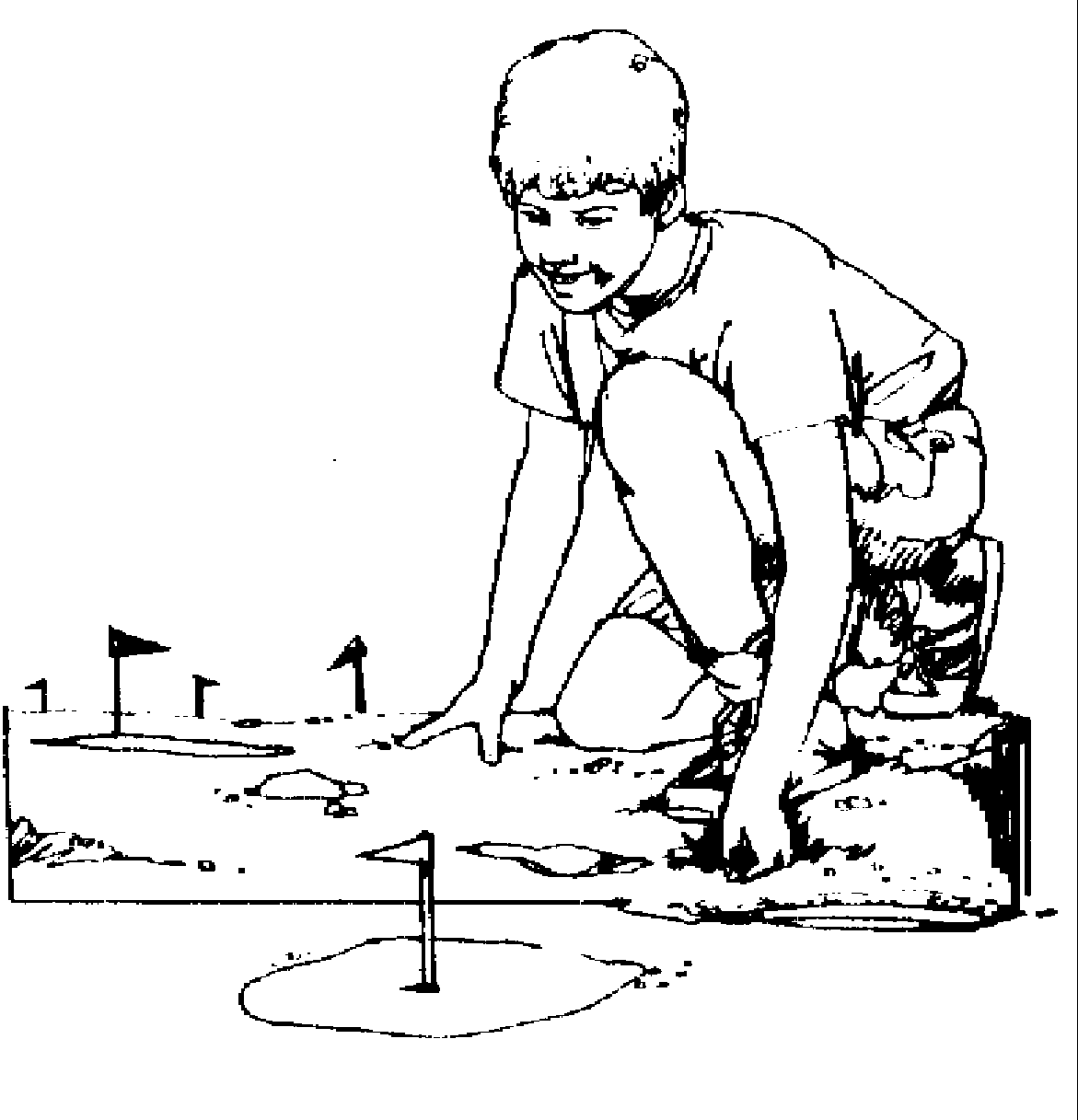 |
HUNKER DOWN
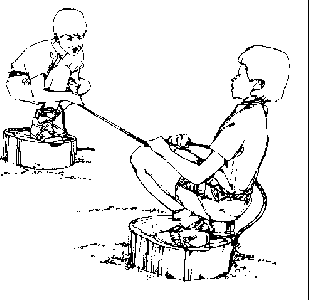 |
You need two
small pedestals, from six inches to a foot high. They could be tree stumps,
overturned five gallon cans (filled with water or sand), wood
blocks, etc. Each player hunkers down on his pedestals, holding the
end of a 15-foot rope. On signal, they begin reeling in the rope, tightening and slackening it in order to unbalance the opponent and make him fall off his pedestal.placed about six feet apart. |
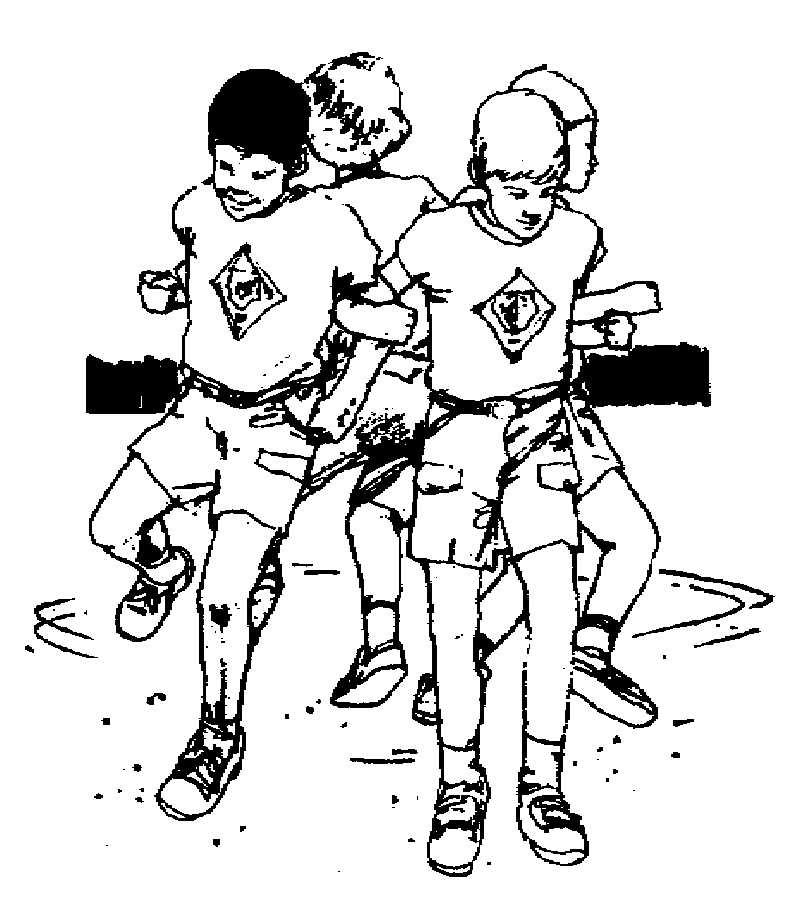 |
| Divide the den into two teams of three or four boys each. Team members line up back to back with elbows linked. On signal they race to a turning line and back. |
| The boys in your den
can have some fun with their PWD cars.
Mark course about 20 feet long on a smooth bare floor. Boys take turns pushing their pinewood derby car toward the target, trying to make them stop in numbered spaces. Let the boys make up the rules
about how to score a car when it straddles a line.
|
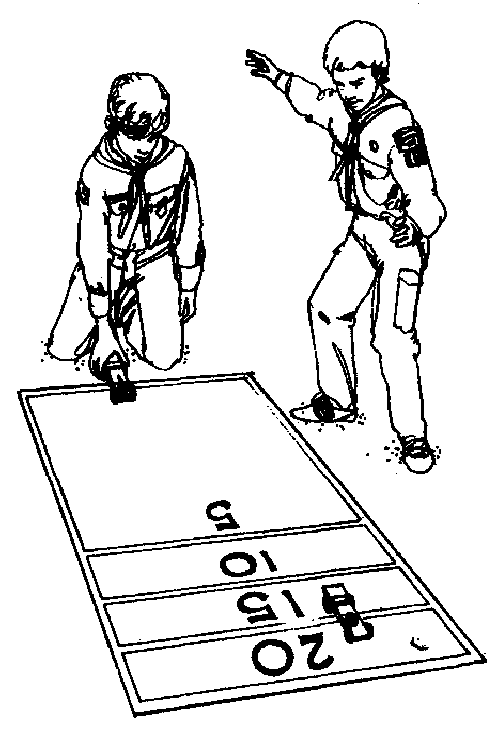 |
| The
Rattlesnake is paper or plastic milk carton or a grocery bag. Stand
it on the floor. Cub Scouts form a circle around it and grasp
neighbors’ hands.
On signal, they try to force neighbors to touch the Rattlesnake while avoiding it themselves. When a boy touches the Rattlesnake, a point is scored against him. |
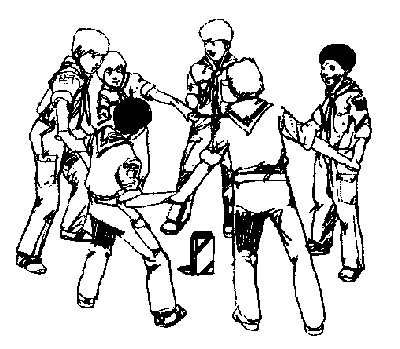
|
TRAVEL GAMES
DO AND ADD
|
Divide the group into four sections. (Sections
play the game separately.) The first player does some physical action such as scratching his head or clapping his hands. The next player repeats the action and adds one of his own (waving an arm or stamping a foot, for example). Each succeeding player tries to repeat all the previous actions and adds one of his own. If he doesn't, he is eliminated. The last player remaining who can repeat all previous actions in the correct order is the, winner. |
LONG GLUM
| See who can keep from smiling the longest. The leader should make faces, giggle, laugh, and tell funny things to try to make players laugh. When a boy or parent docs laugh, he must join the leader in trying to get others to break down. |
QUIET DEN GAMES
MAP READING
|
Divide den into two teams. Each team is given pencil and paper and
told to draw a map showing the location of some relatively small object
within two blocks of the meeting place. (Examples: fire hydrant, bicycle
rack, real estate sign, or flagpole.) Keep teams apart during the drawing;
neither should know what the other's assigned object is. Den leader makes
sure completed maps are not misleading. The teams then exchange maps and study them. Supervised by the den leader and den chief, the teams leave to find the object on the other team's map. Score two points if a map is correctly drawn, one point for finding the object on the other team's map. If both teams earn three points, winner is the one finding the object first. |
DO YOU KNOW?
Give each Cub Scout a copy of the quiz below, or read the
questions aloud. Have the boys write their answers on blank
paper.
|
WHO AM I?
| This is a guessing game in which the leader tells the group only a very general fact about the person he "is" - such as, he is an actor, athlete, military man, scientist, etc. - and others try to guess who he is by asking questions that can be answered with "yes" or "no." (The den leader should make sure the person is not too obscure.) The player guessing correctly becomes the new leader. |
Arm Wrestling
| Each wrestler places the outside edge of his right foot against the outside edge of his opponent's right foot. They grasp right hands. At a signal each tries to force the other to lose his balance. The only contact allowed is their right hands, and the first to move either foot or touches the floor with his hand or body is the loser. |
The Rattler
|
Group forms circle around two
blindfolded boys, each holding a can containing several pebbles. One is
the hunter, the other the hunted. Each must shake his can every 10
seconds. The hunter has 2 minutes to catch his opponent.
Variation: |
|
TARGET BOUNCE Equipment: egg carton, ping pong balls Place an egg carton on the floor. Stand the players about six feet away and give them ping pong balls to bounce off the floor and into one of the egg compartments. Points may be assigned to each of the compartments for scoring. Whoever reaches a predetermined score first may be the winner. The Psychic You need two players who know the secret to play this game. Start off by telling your den that the other person is "psychic" and can identify an object that the first one is thinking about. Have the "psychic" leave the room. The den then picks an object in the room... in this case, a Bobcat badge on Paul’s uniform. Call the "psychic" back into the room. The first player then proceeds to ask the "psychic" a series of questions like:
Is the object I'm thinking of the clock
on the wall? - No SECRET:
The object you "ask" the psychic about before the real object is always
black. You don't always have to say the color because the "psychic" can
tell by looking; this makes the game a little harder.
Is it David's glasses? - No Is it Nathan’s Wolf Book? - No Is it Aaron's black shoes? - No Is it Paul’s Bobcat Badge? - Yes! LOOKING INTO THE FUTURE. This is a continuing story game in which each player tries to add something to a developing story. The game begins, “I looked into the future and..." For example, the first player might begin, “I looked into the future and saw a computer.” The next player might add, “The computer was running a machine,” and the third player continues, “The machine was making doughnut holes.” The fourth adds, “Then the machine went wild and ...“ And so on, with each player adding a new element. Continue until no one can add to the story DUCK DUCK GOOSE In this game, kids sit down in a circle facing each other. One person is "it" and walks around the circle. As theywalk around, they tap people's heads and say whether they are a "duck" or a "goose". Once someone is the "goose" they get up and try to chase "it" around the circle. The goal is to tap that person before they are able sit down in the "goose's" spot. If the goose is not able to do this, they become "it" for the next round and play continues. If they do tap the "it" person, the person tagged has to sit in the center of the circle. Then the goose become it for the next round. The person in the middle can't leave until another person is tagged and they are replaced. Write Your Own Program Explain to the boys that programming is a very exact (and sometimes tedious) job. A computer does exactly what it is programmed to do. This includes programs that run on desktop PCs as well as computer programs in different kinds of machinery (like robots, for example). If the program doesn't include every command, the machine must do, the task won't be done properly. For this activity, tell the boys that they are going to write a program to make a robot move an item from one place in the meeting room to another place in the same room. (Pick start and stop points they can see, but that have obstacles between them.) They are to write out the program commands for the robot, which you will have another Cub Scout then follow. After the boys are finished, shuffle all of the "programs" and give them out so that no one has his own. Then take turns reading each program out, having the "robots" follow the exact instructions from the "programs." TRIO RACE Equipment: Broomstick. Two 18" pieces of rope. Instructions: This variation of the "two-legged" race teaches coordination and cooperation. Tie a rope on each end of the broomstick. Have three (or more) boys straddle the stick, while the boys on the end hold it off the ground by the ropes (adjust if necessary). Mark a finish line and have boys race towards the finish, keeping stick parallel to the finish. Enjoy the Seasons Cub Scouting in the outdoors happens all year long, as you can see from these examples: Winter is a fine time for bird-watching. Follow and identify bird tracks, look for nests, set out bird feeders. It's a time to identify trees without their leaves. And in some parts of the country it's a time to play in the snow; to build snow people, forts, and igloos; to go ice-skating, sledding, and sleigh riding; and to help others by shoveling sidewalks. PING PONG FOOTBALL Divide the den into two teams, kneel on opposite sides of a table. Object is to blow a ping pong ball so that it will fall over the edge of the table on the opponent's side. This scores one point. No one is allowed to touch the ball or the table in any way. AIR ROUTE Players are seated in a circle. Each one is given the name of some city or airport. One player has no chair. He stands inside the circle and calls *All aboard for plane from Oklahoma City to Boston. The two players representing these cities must change seats. The caller, tries to get a seat during the scramble. The player left without a seat becomes the new Air Traffic Controller. This is fun when the Controller names a city which has not been assigned to anyone, thus causing confusion and excitement. I’M GOING ON A HIKE The first Cub Scout says, “I’m going on a hike and in my backpack I put an apple.” ( anything that starts with an “a”.) The next Cub Scout would say, “I’m going on a hike, and in my backpack I put a ball and an apple.” (starts with “b”.) Continue this way, going through the alphabet repeating all the things previously mentioned. Variation: instead of the alphabet, try word length: ( ax, pen, duck, knife, etc.) TIN CAN STILT RACE Players make stilts by running twine or light rope through tomato cans. [See Wolf Book, Elective 7b] The players race to a goal on these cans. Make sure rope or twine is long enough for players to hold it comfortably while standing on can. KNOWLEDGE CIRCLE Have the family sit in a circle. Start some music and pass a button, piece of candy or other item. When the music stops, the person holding the item asks a question about the family. Some examples would be favorite color, hobbies, etc.. WHERE WERE YOU BORN Display a map of the world. Give each boy a colored flag. Have them place the flags where each member of their family was born. Invite some family members who lived overseas to talk about living in a foreign country. Let them provide food from their culture for the boys to sample, see clothes that they wore, etc.. BEAST, BIRD OR FISH Players sit in a circle, with one player in the center. The player in the center holds a soft ball or sponge which he throws as unexpectedly as possible at one of the circle players while simultaneously calling either "beast" or "bird" or "fish". Then he immediately counts to ten. The person holding the ball must yell out a type of animal in the category named, before the count is completed. no words can be duplicated. If the player cannot name an animal, he must change places with the player in the middle. To make it easier for younger kids, you could play this game after an activity about animals, so they have more ideas. Also, decide beforehand what type of things fit in the categories -- you can include insects as beasts, and aquatic creatures (shellfish, etc) as fish to give you a wider range from which to choose. MULTIPLES (BUZZ) This is a game from Taiwan. Players sit in a circle and start counting round the circle from "one." If the agreed figure for the game is seven, each time the number being called includes the figure seven or is a multiple of seven, the player keeps quiet and clasps his hands together. If anyone makes a mistake the leader records a point against him. When the boys become good at this game, add one or two other numbers, so they will have to keep very sharp not to get caught with numbers four, six and eight going on at once. For one number the player clasps hands. For the second number he will put both hands above his head. For the third number he can nod his head. Most players will find thinking of two numbers at once difficult enough. RAINY DAY RACQUETBALL A rousing game of balloon racquetball will brighten up a rainy afternoon - or any afternoon! Make the racquet by bending a wire clothes hanger into a circle. Slip the wire circle into one leg of a pair of pantyhose. Tie off the pantyhose at both ends of the circle. Cut off extra stocking. Flattening the hook of the hanger makes the handle. Cover the handle with masking tape. Make a comfortable grip by building up with strips of cloth or paper, then finish off by wrapping smoothly with tape. After making two racquets, blow up some round balloons, find a partner and have a ball. LAME CHICKEN Divide the boys into two teams and give each team 10 sticks about 10 inches long. The sticks are placed about 10 inches apart like the rungs of a ladder. On signal the first boy in each team hops on one foot over all 10 sticks. He then reaches down and picks up the 10th stick and hops back over the other 9 to his team. The second boy then begins, hopping over the 9 sticks, picking up the 9th and returning. Continue until all have raced. The last boy in line hops over all remaining sticks and then picks up all of them as he hops back to the finish line. If a player steps on any stick, he must start over from the starting line. First team through wins. PIONEER WENT TO SLEEP Everyone stands in a circle. The first player begins by saying "Pioneer went to sleep." The rest of the group answers "How did Pioneer got to sleep?" The leader then says "Pioneer went to sleep like this, like this," repeating a small gesture such as nodding the head or twisting the wrist. The rest of the group mimics the gesture and answers "like this, like this." The entire group continues to repeat the gesture as the next boy in line says "Pioneer went to sleep," and others respond as before. The second boy adds another gesture to the first, so that now there are two movements to keep going. The game continues around the circle, each player adding a gesture. By the end of the game, the entire group should be a foot-wiggling, eye-blinking, head-shaking, nose-twitching mess. Try to add as many gestures as possible before the game totally falls apart. Since it is difficult to do more than ten gestures at once, you may not get everyone in the group, but the challenge is to see how far you do get. Start off slowly with small things, such as toes and fingers, and work up to the bigger things, such as arms and legs. FROGS AND FLIES (WINK MURDER) The more participants the better. A detective is chosen. He stands in the center of a circle of Cub Scouts, all sitting down. Everyone closes eyes tightly while the leader goes around the outside of the circle and secretly taps one of them. This person is the frog. The leader informs everyone to open their eyes. Now, the frog's job is to eat the flies; the flies being the others in the circle. The detective's job is to try to guess which one is the frog. The frog tries to "eat" as many flies by making eye contact with others in the circle and sticking out his tongue at them without the detective seeing him. Once he has stuck his tongue out at someone, they extend their legs straight forward, or they can lie down, indicating that they have been "eaten". The detective watches for the frog, while the frog tries to "eat" as many flies as he can before being discovered. The detective gets 3 chances to guess who the frog is. Then, the frog turns into the detective, and the leader chooses a new frog. THE FLYING DOUGHNUT • 1 rope (length around 15') • A 'doughnut' tied to one end of the rope to act as a weight. An old cub cap or rolled-up hiking sock is ideal. This is an old playground game which used to played with a long skipping rope. It works very well both with small groups and large groups. Spectating can also be quite fun so don't worry too much about players which have been hit standing out for a few minutes. The players stand in a circle with the leader in the middle. The leader swings the rope and doughnut around in a large circle at around foot height. The players must jump over the rope and doughnut each revolution to avoid being hit. If they are hit (or hit several times) they are out of the game. The last people standing in the circle are the winners. To rotate the doughnut stand up and swing the rope, swapping it from hand-to-hand around you. As you spin the doughnut faster it may rise too high—some players may not be able to jump high enough. You can often help by crouching down or reducing the speed. Look out for players who try to stay back from the circle slightly trying to ensure that the doughnut will never reach them. SCAVENGER HUNT A scavenger hunt is always a lot of fun. Depending on the ages of your participants, you may have to develop different task lists. For instance Tiger Cubs may not yet be able to identify leaves whereas Webelos might be expected to know some of the more common trees and leaves in your area. You can combine the participants into groups, even mixing the older boys with the younger boys. Just be sure that each boy will have a chance of making a "find." Some suggested items for a scavenger hunt include: FIVE DOTS Equipment - Pencils and Paper Game Description - Each player has a piece of paper and a pencil. He/she puts 5 dots anywhere on the paper and passes the paper to another player. The second player has to draw a person with head, both hands and both feet each touching a different dot. After a set time, eg. 3 minutes, all display their drawings. Leader picks out the best, neatest, funniest, cleverest etc. TURKEY HUNT Basically it goes like this , you divide the boys into two teams . One team is the Native American Indians & Pilgrims and the other team is the Turkeys . The turkeys squat and walk like turkeys back and forth . I did it outside , we just set up borders to limit the turkeys area to walk in . I also decided to make it a little harder and gave each Turkey a red sock "gobbler" to wear from their shirt , hanging down from the neck . If it fell off they were hit as well , it gave them an incentive to pay more attention . Any ways , the other team can pick to be a Native American Indian or a Pilgrim . I used those great nurf arrows . They could choose a bow and arrow or a ball " nurf ) shooter . They each got got three shots , if they hit a Turkey , the Turkey falls and is out . The object is to see which team can get the most Turkeys . They both switch when all scouts have shot their three shots . It was so fun , the boys really got into making Turkey noises . GET UP Contestants sit on the ground, back to back with legs extended. Sit the Cubs in a circle. One Cub walks around the outside of the circle, tapping each boy on the head saying "duck, duck..." At some point he changes the name to "Goose!" The "goose" must get up and chase the caller around the circle. The first of the two of them to get back to the place where the "goose" was sitting gets to sit back down, and the other then must go around the circle again, tapping each boy on the head saying "duck, duck, GOOSE!" feet together and arms folded. At a signal they try to rise to their feet without unfolding their arms. First one is winner. THE RATTLER Group forms circle around two blindfolded boys, each holding a can containing several pebbles. One is the hunter, the other the hunted. Each must shake his can every 10 seconds. The hunter has 2 minutes to catch his opponent. MINUTE JUDGING Everyone is in a seated position. The leader looks at his watch, says "Go," and everyone tries to judge when a minute is up. Each indicates his guess by standing. The closest to the correct time is the winner. TRIBE OF THE BLIND Blindfold the boys and stand them in a circle with their arms outstretched so that they can just touch the fingers of each other. In the middle have two Prisoners who are chained together with a neckerchief around the right legs. The prisoners are not blindfolded. The two prisoners try to escape without being caught. The blindfolded boys can not bend their knees and can only try to tag the prisoners when they hear a sound coming toward theme. WE FOUGHT HARD FOR THOSE 50 STARS Divide the group into equal teams lined up a few feet away from the table. Place a bowl on the table for each team. Lay 50 cutout paper stars (approximately 2 inches in diameter) out on the table beside each bowl. Give each player his own straw. On a signal, the first player in each team runs forward and picks up one star, or as many as he can with one breath, by sucking on the straw, thus holding the star to the end of the straw. No hands! He releases the stars into the bowl, and then runs to tag the next player and gets at the end of the line. (He may need to run again.) The first team to have all 50 stars in the bowl is the winner. (The game could be varied with the original 13 stars tot a smaller group of boys.) Team Work Transportation Create a mode of transportation using lengths of PVC pipe and a piece of 2" x 4" plywood. Lay 4 or 5 pieces of pipe on the floor. Top with the plywood. One cub sits on the plywood while the team pushes him, rolling on the PVC. As the passenger moves, the team must pick up the pipe and lay ahead of the rolling Cub. This becomes an involved team effort. Tool Charades Instead of a title or saying, give the boys the names of tools. Each must then get his team to guess the tool by pantomiming its use. KIM'S GAME The Scoutmaster should collect on a tray a number of articles-knives, spoons, pencil, pen, stones, book and so on-not more than about fifteen for the first few games, and cover the whole over with a cloth. He then makes the others sit round, where they can see the tray, and uncovers it for one minute. Then each of them must make a list on a piece of paper of all the articles lie can remember-or the Scoutmaster can make a list of the things, with a column of names opposite the list, and lot the boys come in turn and whisper to him, and he must mark off each of the things they remember. The one who remembers most wins the game. THIMBLE FINDING The patrol goes out of the room, leaving one behind who takes a thimble, ring, coin, bit of paper, or any small article, and places it where it is perfectly visible, but in a spot where it is not likely to be noticed. Then the patrol comes in and looks for it. When one of them sees it he should go and quietly sit down without indicating to the others where it is, and the others, if they see it, do the same. After a fair time any one of those sitting down is told to point out the article to those who have not yet found it. The first one to see it is the winner, and he sends the others out again while he hides the thimble. HOW LONG ? A good camp practice is to see that all Scouts have a piece of paper and pencil, and to make them write down answers to various questions regarding lengths and heights. For instance: " What is my height when I'm wearing my hat ? " " How long is the camp table ? " Of course that boy wins who most nearly gives the correct number of inches. BLOW BALL The players divide into two sides and take their positions at each end of a wooden table about 6 feet long. A ping-pong ball (or any light celluloid ball) is placed in the center, and each side tries to blow it off the table at the other end-if it goes off the sides it does not count, but is put back in the center again. The game soon develops strong lungs, but needs composure just as much-because the best player is the one who can blow without laughing at the faces of those opposite him as they blow. It is best to play kneeling or sitting round the table. A more complicated way for five players a side is to have a goal at each end marked on the table ; then each side has a goalkeeper, two forwards, stationed at the other end to blow into the enemy's goal, and two backs to pass the ball to their forwards. SPOTTING THE SPOT Show a series of photos or sketches of objects in the neighborhood such as would be known to all the Scouts if they kept their eyes open-for instance, cross-roads, curious window, gargoyle or weathercock, tree, reflection in the water (guess the building causing it), and so on, and see who can recognize the greatest number; or else let each Scout contribute a picture or sketch of something remarkable passed during the last outing. SCOUT'S NOSE Prepare a number of paper-bags, all alike, and put in each a different smelling article, such as chopped onion in one, coffee in another, rose-leaves, leather, aniseed, violet powder, orange peel and so on. Put these packets in a row a couple of feet apart, and let each competitor walk down the line and have five seconds' sniff at each. At the end he has one minute in which to write down or to state to the umpire the names of the different objects smelled, from memory, in their correct order. GAMES FROM OTHER COUNTRIES THE WHALES from Denmark Divide den into pairs and give each pair the name of a fish: Swordfish, Dolphins, Tuna. etc. They are seated in pairs around the room. One pair is called the Whales. They wander, hand in hand, around the room, calling as they go, ‘Swordfish,’ ‘Dolphins,’ etc. As their name is called, the pair gets up hand in hand and follows the Whales. When all fish are following the Whales, the Whales call, ‘A storm is coming. Head for home.’ Still holding hands, all the fish scramble to find seats. The unsuccessful pair becomes the new Whales. KASHA MU BUKONDI from Africa (Antelope in the net) Den forms a circle by joining hands around one Cub Scout, the Antelope. The Antelope tries to break through the circle. When he does, all the Hunters give chase. When the Antelope is tagged, he joins the circle and the Hunter who tagged him becomes the Antelope. HOLD THE ROPE from Israel Divide the den into two teams. About 20 feet in front of each team, mark a circle on the floor or ground. Members of each team put their Cub Scout caps in their circle and go back to the start. Give each team a length of rope at least 10 feet long. On signal, the members of each team grab their rope WITH BOTH I HANDS and run to their circle. Then they help each other to put on their caps, using knees, feet, teeth, and elbows. They may not use hands, which must hold the rope. The team that gets back to the start with their hats on wins. THE FISHERMEN from Ghana Draw a large irregular shape on the floor or ground to represent the lake. Three or four den members are chosen to be Fishermen. The remainder are Fish. Give the Fishermen a rope 10 to 15 feet long. The game begins with the Fish swimming in the lake while the Fishermen “wade” in with their net (the rope). The Fishermen sing any song as they wade. When the song ends, the Fishermen try to net the Fish by get- ting the rope around them. The Fish may go to the edge of the lake where they are safe because the “net” can’t reach them there. Fish who get caught join the Fishermen for the next round. The game continues until all fish are caught or until a certain time limit is reached. CATCH IT, HEAD IT from England The den forms a large circle or square, facing inward. The leader stands in the center with a soccer ball while calling, “Catch it!” or "Head it!” he tosses the ball to one of the players. The player must do the opposite of what is called. If the leader calls, “Catch it" the player “heads” the ball as in soccer. If the call is “Head it!” he must catch it. Score one point against a player who does the wrong thing. DAKPANAY from the Phillippines Make three small circles on the floor, each with room for one or two players to stand in. Also make a large “rest circle.” One player is the Chaser, the others are circle players. The Chaser must stay out of all circles. The circle players may run between circles. Circle players are safe as long as they are in a circle. When one is tagged between circles, he becomes Chaser. CAT AND MICE from the Philippines All players sit or kneel on the ground around a small pile of objects—sticks, stones, or marbles. One player is the Cat, who sits nearest the pile. The others are Mice. The Mice try to snatch one of the sticks and toss it over their shoulder before the Cat can tag them. When a Mouse is tagged, he becomes the Cat. DROP THE MARBLE from Central America A two-boy marble game. Each player is given five marbles. One player stands with his heels together, toes spread wide. The other player kneels about five feet away and tries to toss a marble so it stays between the feet of the other. If he fails, he loses the marble. If he succeeds, the standing player drops one of his marbles from waist height, trying to hit his opponent’s marble. If he hits it, he takes the marble. If not, he loses his own marble. The players change places for the next round. RELAYS T-SHIRT RELAY Break your group into two equal teams. You give an oversized T-shirt to each team, one large enough to fit all the players on each team, (the largest player on any team determines the size of the T-Shirt needed). Have the two teams line up. The first person in line puts on the T-Shirt. They turn and face the second player in their team's line. The first and second players both hold each others hands. Then when you say GO, the rest of the team in their line pulls the shirt up and over the first players head, down the first player's arms and up the arms of the second player and over the second player's body (the shirt will be inside out at this point). Then the second player turns and faces the third player and the team repeats the process. They continue this all the way down their team's line until the last player is wearing the T-shirt. The team to transfer the T-shirt through their whole team first wins. If you want to make the game last longer, have them relay the T-Shirt all the way to the last player and then back up the line to the first player again. This could be a funny game to see played on a Cub Scout or Boy Scout Family night or just for fun anytime. If you have a lot of parents on a family night you could have the adults play the game and the boys could watch. I think the boys would get a big kick out of watching the adults compete. Then when the adults are done you could have the boys do it and the parents could get a laugh. BUBBLE BLOWERS RELAY Make a starting line and a finish line. Divide boys into 2 or more teams. Pick a team leader for each team. His job will be to blow a bubble for the first boy on his team. The boy will fan it with a paper plate until he gets to the finish line. If his bubble breaks the boy stops where he is and waits for his team leader to come and blow a new bubble for him. When everyone on the same team has had a turn and fanned a bubble over the finish line they win. BACK-TO-BACK RELAY The boys are divided into relay teams of two and take their place behind the starting line. The two boys stand back-to-back and link arms so that one will walk forward and the other backward. At the signal, the two pairs head for the goal, when they get there, they reverse direction so that the one who was walking backward is now walking forward. They continue walking until they get back to the starting line to touch off the next two players on the team. ART CONSEQUENCES The first player in each group walks to the end of the playing area, picks up the pencil and draws the head of a man, woman or child. After he draws the head, he folds the paper so that only the neck shows. He then walks back to his Den and tags the second player in line. The second player walks down and draws the shoulders, folds the paper, walks back and tags the third player. The relay continues on down until the figure is complete with waist, hips, legs and feet. The fun of this relay is opening up the piece of paper and passing around each 'creature' that each Den has created. DIZZY IZZY Line up the Dens for a relay race. Have the first player in each line run up to a given point, place one finger on the floor, revolve around his finger seven times, and run back to tag the next player in line. Repeat until all have had a turn. Keep the runners away from the walls and other obstacles. Variation: Give each team a baseball bat or equivalent. Have the boys run up, put the bat against their forehead, the other end of the bat on the floor and revolve around the bat three or four times. ORANGE CHIN CHIN RELAY A Relay for Two Equal Teams Equipment: 2 oranges Divide the players into two teams, and stand each team in a line. Each team leader then tucks an orange under his chin. On the word, "GO!", he must turn around and transfer the orange to under the chin of the next team member without the Use of hands. The winning team will be the one which has successfully transferred the orange right down the line without dropping it. If it drops, the team must start again. PENNY DROP Pour water about 6” deep in a bucket and drop in a dime. Each player is given 6 pennies. In turn, players drop their pennies in the water, trying to cover the dime with their penny. The successful player wins the dime. RAINY DAY WASH RELAY First player in each relay team is given a gym towel. Two players from each team hold up a rope at finish line to resemble a clothesline. At signal, the first player runs to the line with his towel, places it over the line so that the bottom edges of towel are even, changes places with one of the line holders. The former line holder runs back touches off next player to runs to the line, removes towel and takes it back to next player. The same players may hold the line throughout the game, but it is more fun If they change each time the towel Is placed on the rope. Variation: Player fastens 3 articles of clothing to line with clothespins. Next player removes them, etc. BEANBAG HOBBLE KICK Each relay team is furnished a beanbag and an inner tube rubber band. The relay is run in pairs. The first pair places the rubber band over the ankles of their adjacent feet, hobbling them together. They kick the beanbag to the goal line and back. Then they remove their hobble and pass it on to the next pair. CUP AND BOTTLE RELAY This is an exciting and 'wet' relay which needs to be done outdoors. Form two relay teams with a bucket of water and a cup at the head of each line. At the foot of each line, place a bottle. At starting signal, the player nearest the bucket dips up a cup of water and passes it down the line. The last player in line pours it into the bottle, runs to the head of the line, and so on, until the bottle is filled. SPUD SPEAR RELAY Provide each relay team with a fork. Potatoes are arranged on a course from four to twenty feet apart, depending on the space available. The first runner on each team runs to the first potato, spears it with his fork, carries It back and drops in in a pall or basket before handing the fork to the next player. EXPLOSION RELAY Relay teams line up at equal distance from stacks of paper bags. Each player races to the stack in front of his line, blows up a paper bag, breaks it with his hand and races back to touch off the next player. TIRE ROLLING RELAY Players roll a tire to a turning line, roll it around a stake or chair, and roll it back to the next player in line who repeats the action. Arrange the players in a circle, call out the names of things that are found above the ground or below it. For example: strawberries grow above the ground and potatoes grow below. When you call something that grows above the ground the players stand up, below they sit down. The players are eliminated when they miss or are extra slow about deciding. It is most helpful if you have a list ahead of time for this ~ so it goes fast and smooth. MATCH BOX RELAY Form relay lines. First person in each line sticks a penny match box cover over his nose. He transfers it to the nose of the next person in line without using his hands or feet. Team to finish first wins. THROUGH THE TIRE RELAY Each relay team has a tire, held by the first player. At signal, he goes through the tire, !lets it fall to the ground and stands at attention. The next player sets up the tire and repeats the action. Continue until all boys on team are standing at attention. The hands must not touch the potato at any time. TWENTY COUSINS Players line up in relay formation. At the other end of the room, in front of each relay line, is a pile of 20 clothespins. On a signal, the first boy in each line runs to the pile of clothespins and picks up all 20. He then returns to his line and hands the clothespins, one at a time, to the next boy in line. The second boy then passes the clothespins, one at a time, to the third boy, and so on down the line until the last boy in the line receives all 20 pins. This last boy then runs to the front of the relay line and sits down. All the team members then sit down, too, showing that the entire line is finished. The first team to have all its members sit down is the winner. If a player drops any clothespins, he must pick them up and play continues by passing them to the next player. No penalties are given and it is not necessary to start over. Back to Index WET GAMES WATER BALLOON CATCH
The objective is three boys holding a large polythene sheet or ground sheet, who will try and catch the water balloons. The team with the most catches wins.
This is a very messy game and is therefore ideal for hot days at camp. Your net or rope is stretched between two poles or trees just above head height. You have two teams and one balloon a quarter filled with water. If you put too much water into the balloons then they tend to burst too easily. The object of the game is to lob the balloon over the net and try and soak the opposing team. Each team has a sheet which is held by all members of the team. The balloon must be served, caught and returned only by using the sheet. There is a lot of strategy in this game on such things as catching the balloon without bursting it and ways of lobbing the balloon to make it difficult to catch. When the balloon bursts on one side then a point is awarded to the other side, and a new balloon is brought into play. WATER BALLOON RACE This race is for the whole family. Give each player a balloon filled with water and a 30-inch long string. The players tie one end of their string to the balloon and the other end to one ankle. On a signal, all players move toward the finish line 20 feet away dragging their balloons behind them. A player whose balloon breaks must step out of the game. The winner is the first player whose intact balloon crosses the finish line. CUP AND BOTTLE RELAY This is a very wet relay, so play it outside. Form two teams. Place a bucket of water and a cup at the head of each line. At the end of each line is a bottle. On signal, the first player dips his cup in the water and passes the cup down the line. The last player pours the water carefully into the bottle. Then he runs to the head of the line. Repeat until the bottle is filled to the line marked. SPONGE SQUEEZE RELAY Get 4 buckets or large containers and
6 large sponges. Divide the boys into 2 teams and form 2 single file
lines. Put a bucket in front of each team and bucket at the “finish” line
of each team. Put equal amounts of water in the buckets in front of
the teams and put 2 or 3 sponges in the water. MUG RACE
Fill one Dixie with
water and place the Dixie's at either side of the hall. Distribute a mug
to each person. The team must transfer the water from one Dixie to the
other passing the water from one mug to the next. Could be marked in
several ways: Time to move fixed amount of water with penalty for water
dropped, or volume of water moved in fixed time. WATER GUN SOCCER You need a water pistol for each player and one
big balloon.Mark off two goal lines about 30 feet apart. Behind each goal
line, place a bucket full of water PING-PONG POOL Start with a very small, blow up type pool. Mark the pool bottom across the center with masking tape or, if alright, paint it. It could also be marked by laying something in the bottom that will not float. Have half of the boys go to one side and the rest go to the other. Put a Ping-Pong ball in the center of the pool. Using only their bare feet dangling over their side of the pool to move the water (they may not touch the ball), the boys try to move the ball to their side. Begin playing music and stop the music at irregular intervals. The side the ball is on gets a point. At the end, the side with the most points is the winner. Webelos Den Games
Provide each player with a 5
foot length of 1/4 in. rope. Divide the group in half, having two parallel
lines face each other about three feet apart. On the signal "go"! each
player passes his rope around the waist of his opponent. He then ties a
predetermined knot in his rope and tries to pull his opponent over the
line.
A blindfolded "sentry" sits in
the center of the campfire area. In front of him lies a sheathed axe. The
players try to creep up and steal the axe without being heard. The sentry
points at thieves if he hears them. If a player gets pointed at, he
must return to his starting place. The first person to steal the axe
is the next sentry. (Can also be played with axe stuck in a log or with
other objects.)
Game Description: A
traffic cone or similar object is placed in the middle of the hall. All the
players then form a large ring around it.
The idea is to make all the
other players out by making them touch the cone. If anyone does touch it,
then they are out. The winner is the last person still
in.
BOUNCE BOWLING Equipment: Three rubber balls the same size (any size works, from tennis to basketballs). Five or six cardboard boxes of various sizes. Object: Bounce the
balls into the box. Smaller boxes yield higher scores.
Instructions:
Decide how many points to award for each size box; mark on boxes in
bold numbers. Draw a throwing line for players which players must stay
behind. Arrange boxes about 8-10 feet from players. One by one, players
bounce balls toward boxes, scoring points as shown on the boxes. Repeat
for 5-10 tums; winner is highest score. Altamate: Pick a score (perhaps
101) and players throw balls until they reach goal exactly. Scores which
are over the goal are subtracted from the current
total.
|
YOUTH VS. AGE QUIZ
| A popular radio quiz program in 1939 was NBC's "Youth vs. Age," in which the juvenile team tried to answer questions created by the adults and the adult team tried to answer questions created by the youths. Have a pack committee member compile a list of questions about local attractions or children’s culture that have been created by youth members of the pack. Give a copy of the quiz to all the adults at the pack meeting and ask them to answer the questions as best they can. |
BLUE AND GOLD PASS
|
You will need: 12 Clothespins painted
gold, 12 clothespins painted blue, two empty bags or boxes
How To Play: Divide boys into two teams. Each boy holds the hands of his teammates on either side. On signal, the first boy on each team picks up a clothespin from his pile. He must pass it to the next without dropping hands. The last person drops the pin into the box. If pin drops to the ground players must pick it up without letting go of hands. |
FEED THE GUEST
| This is a good game to play at a Blue and Gold Banquet. Each side of the table plays against the other side.Place a napkin, bowl of gumdrops, and a package of toothpicks at the end of the table for each team. At the signal, the first person on each side ties the napkin around the neck of the person sitting next to him, spears a gumdrop, and feeds it to that person. This person then unties the napkin from around his neck and repeats the procedure with the next person. This continues on down the table until everyone has been fed! |
| This
is a series of tests for each den leading to the discovery of Bigfoot.
It can be adapted to either indoors or outdoors, but if you have a
choice, make it out-doors. The object of the hunt is to cornplete the
tests and find Bigfoot in the shortest time.
Station 1—Climbing the Mountain Build a string trail, with the string leading high and low between tree trunks branches, etc. The den is blindfolded and each member follows the trail by sliding one hand along the string. (If in doors, run the string from chair to table to side of the room and back again.) Station 2—One member of the den is lost and presumably injured in the mountains. That Cub Scout is sent some distance away and left lying on the ground The other den members must find him apply simple first aid, and bring him back on a stretcher made from two poles and a blanket. | |
| Station
3—Finding Shelter. On the way up the mountain, a fierce storm stops the
den. The boys must build a shelter with a blanket and a few poles that
all den members can get under Station 4—After the storm, the den finds Bigfoot’s footprints near their camp. (The footprints are huge cardboard cut outs of an ape’s print and lead toward a wooded area or, indoors, toward another room). Station 5—As the den follows the foot prints, the boys see Bigfoot (a leader in a fur coat and mask) scurrying off into the woods (or other room). The game ends when the den tags Bigfoot. Start dens at four- or five-minute intervals. Time each start. The winning den is the one which tags Bigfoot in the shortest time. |
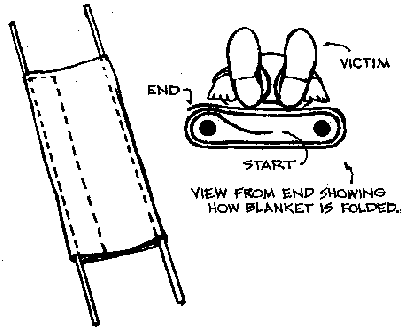 |
| This is a series
of races for turtle figures the boys have cut from such materials as
heavy cardboard, plywood, or floor tile material. The turtles are hung
on a 20-foot cord through a hole in the head and raced by “walking”
them—alternately tightening and relaxing the cord so that they appear to
be walking toward the finish. All turtles must be the same size so that they can “walk” a line set at the same height for all. The pack conunittee might suggest that all turtles be seven inches long. The committee must make one pattern for each den by enlarging the figure shown here by the grid method; each square represents one inch. |
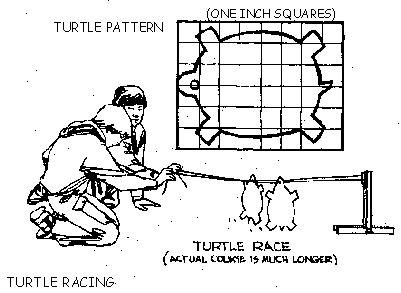 |
| Dens
could cut their turtles from any material they wish, or the committee
could establish a required material. Of course the turtles can be made almost any size. You might want to involve parent help and make giant sea turtles about 3 or 4 feet high. | |
|
Each contestant has a suitcase
or backpack and an umbrella. In the suit-case are a hat, a coat, gloves, and
any other clothing desired, so long as the contents are the same for each
player. At a given signal, all contestants run to the goal, open suitcases,
put on clothes, close suitcases, open umbrellas, and run to starting
point.
Use of the relay adds
excitement.
This is a great game for pack
meetings,especially if parents are the
contestants.
GIANT STICK FIGURES
LEAN-TOO A good game for the pack meeting to get parents involved. The boys and parents stand in a circle by dens holding hands. Everyone numbers off alternately one or two. On the signal, keeping legs and backs as straight as possible, the players who are "ones" lean forward toward the center of the circled, while the "twos" lean outward. Players counterbalance each other for support. Once the group has gotten its balance, slowly reverse the leaners. Then have the players see how smoothly they can alternate. CAPTURE THE FORT Divide players into two sides: Attackers and Defenders. Defenders form a circle, holding hands and facing outward, with their captain in the centre. Attackers surround the fort at about eight or ten paces distant. They try to kick a soccer ball into the fort; it may go through the legs of the defenders or over their heads. If it goes over their heads, the captain may catch it and throw it out. But if it touches the ground inside the circle, the fort is captured and the players change sides. Start with all the players facing in the same direction with their arms spread to their sides - this should create a number of rows. On the command 'Turn' everyone should turn 90° - don't be too worried which way just as long as it is a quarter turn. This changes the maze from rows to columns. Two players a 'cat' and a 'mouse' will run around the maze, the cat trying to catch and tag the mouse. They may run around the maze and along the lines of arms but must not pass or stretch across them. You can shout 'Turn' at any point during the game to change the maze. Thus you may suddenly prevent the mouse getting caught or put the mouse very close to the cat. When the mouse is caught start again with another pair or start with a new mouse and allow the old mouse to 'grow' to a cat. PRE-OPENING ACTIVITY
Answers
PRE-OPENING
(Answers: 1. I, 2,H 3,D 4,F 5,B, 6,J, 7,A 8,E 9C,10,G) BB
"Corn was the most important food the Indians gave us. Circle everything you believe to be made from corn." (The answers is everything on the list, of course, but don't reveal that until all have worked their paper.)
BB
| ||||||||||||||||||||||||||||||||||||||||||||||||||||||||||||||||||||







